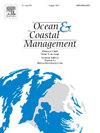How erosion of salt marsh edges leads to the loss of organic carbon: Insights from Jiangsu coast, China
IF 4.8
2区 环境科学与生态学
Q1 OCEANOGRAPHY
引用次数: 0
Abstract
Salt marshes are important blue carbon ecosystems, demonstrating significantly higher rates of organic carbon (OC) burial than terrestrial forests, thus playing a crucial role in mitigating global warming. However, these ecosystems are inherently fragile and vulnerable to degradation due to a variety of environmental stressors. An accurate assessment of the carbon sink capacity of salt marshes requires a comprehensive evaluation of OC burial and OC loss. Previous studies have often focused on quantifying OC loss roughly at large scale, while there has been less discussion about adequately addressing the geomorphological processes that drive such losses at finer regional scale. In this study, we investigate OC loss due to edge erosion in the salt marshes of Jiangsu, China, utilizing an integrated approach involving field surveys, remote sensing, and geochemical analyses. The results indicate that soil erosion is the predominant mechanism of OC loss. Furthermore, OC loss within sediments is principally determined by the erosion height and the OC content. The study also finds that autochthonous OC is more susceptible to decomposition and remineralization than allochthonous OC. From 2014 to 2021, the annual OC loss in Yancheng, Jiangsu Province, offset approximately 32 % of the OC sequestration. These findings aim to enhance understanding of OC dynamics in eroded salt marshes and emphasize the necessity for targeted management strategies to maintain the long-term carbon sequestration potential of these critical ecosystems.
盐沼边缘的侵蚀如何导致有机碳的流失:来自中国江苏沿海的见解
盐沼是重要的蓝碳生态系统,其有机碳埋藏率明显高于陆地森林,因此在减缓全球变暖方面发挥着至关重要的作用。然而,这些生态系统本质上是脆弱的,容易因各种环境压力而退化。准确评价盐沼碳汇容量需要综合评价有机碳埋藏和有机碳损失。以前的研究通常侧重于在大尺度上大致量化有机碳损失,而在更精细的区域尺度上充分解决驱动这种损失的地貌过程的讨论较少。本文采用野外调查、遥感和地球化学分析相结合的方法,对江苏盐沼边缘侵蚀造成的有机碳损失进行了研究。结果表明,土壤侵蚀是土壤有机碳流失的主要机制。沉积物中的OC损失主要由侵蚀高度和OC含量决定。研究还发现,原生OC比外来OC更容易分解和再矿化。从2014年到2021年,江苏盐城每年的OC损失抵消了大约32%的OC固存。这些发现旨在加强对侵蚀盐沼中有机碳动态的理解,并强调有针对性的管理策略的必要性,以保持这些关键生态系统的长期碳固存潜力。
本文章由计算机程序翻译,如有差异,请以英文原文为准。
求助全文
约1分钟内获得全文
求助全文
来源期刊

Ocean & Coastal Management
环境科学-海洋学
CiteScore
8.50
自引率
15.20%
发文量
321
审稿时长
60 days
期刊介绍:
Ocean & Coastal Management is the leading international journal dedicated to the study of all aspects of ocean and coastal management from the global to local levels.
We publish rigorously peer-reviewed manuscripts from all disciplines, and inter-/trans-disciplinary and co-designed research, but all submissions must make clear the relevance to management and/or governance issues relevant to the sustainable development and conservation of oceans and coasts.
Comparative studies (from sub-national to trans-national cases, and other management / policy arenas) are encouraged, as are studies that critically assess current management practices and governance approaches. Submissions involving robust analysis, development of theory, and improvement of management practice are especially welcome.
 求助内容:
求助内容: 应助结果提醒方式:
应助结果提醒方式:


